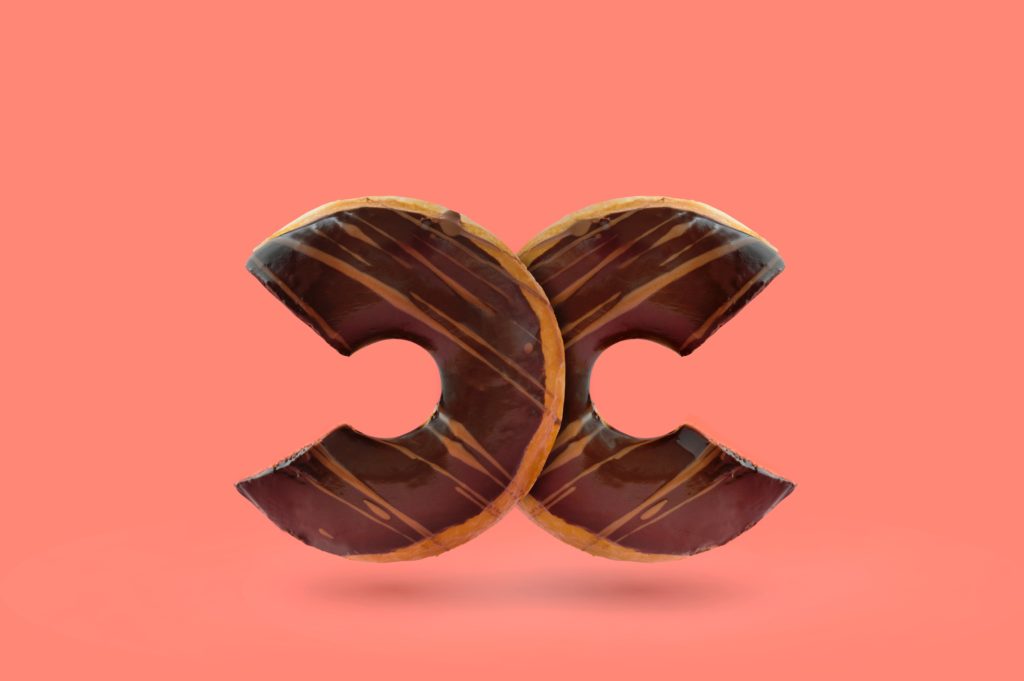Building a successful startup with a middle of the road brand starts you on the back foot immediately. If your startup brand design doesn’t stand out from your competitor pool, if your differentiator(s) are obscure or non-existent, if your creative strategy is incomplete or unclear, all these things can sink your ship immediately. Let’s hold for a moment and focus on my first point. Your logo is the tip of the spear for your brand.
Falling prey to design trends

Dope Donuts by Stoica Ionela
Every year new design trends emerge and entice designers to fall in line with the shiny new methodology. While riding the subway to work every morning, I like to play the “What’s that company?” game. It feels like every day a new advert materializes on the train marquee with a solid pastel color background accompanying a geometric sans serif logotype. Maybe there is a product shot, maybe not. I can rarely differentiate any of these companies. The similar creative directions for so many different companies make the brands feel generic and “out of the box.” Almost as if you had your brand built by a computer.
The magic is in the execution. You can set your logo in the geometric sans serif of your choice, but make sure you build a unique brand around said logo. One that speaks to your audience’s needs and answers a burning question they have about your vertical. If your mattress brand advert looks similar to a male enhancement company at first glance, you probably already lost.
(I can’t remember the company names from the subway ads since they were all so similar so image above is of dope donuts by Stoica Ionela on Unsplash )
Not utilizing metrics

This guy is dripping in data – photo by Adeolu Eletu on Unsplash
Why is your logo a sans serif? Why did you choose that brand color? While working with clients on a brand design, I write down all the why’s I can think of before a presentation. If I can’t answer each why question with a quantifiable metric, then I am operating on feelings. When it comes to the design, your client’s feelings outweigh yours every time. It is, however, hard to argue with metrics. If you are not leveraging some data to inform your designs and strategy, you are building a house on sand. At any point, the tides of competition or pivoting priorities can erode your brand’s foundation and leave it floating out to sea. Did that metaphor work? I have no data to back it up.
Not paying back your design debt

Put on some tunes and pay back that design debt – Photo by Tamarcus Brown on Unsplash
Startups have to be nimble and work fast. When we started at Zipari, we had precious little time to work on the brand as we had three clients right out the gate and products had to be built. If I remember correctly, I had two weeks to work on the brand before I had to switch gears and start developing our core products. That was well over four years ago. Today the design team has grown, and I have the time to go back and repay the design debt I took on to help get the company up and running. That includes crafting the brand’s visual system, working with Marketing to find our voice, and utilizing our product design system as a part of our design story.
Always remember to pay back your debt. Maybe you fell prey to trends early on so you can get started. Now it’s time to solidify your brand.
Don’t be passive
I am guilty of this. I have allowed others to dictate the design of specific pieces of content that require brand oversight. Given my growing list of to do’s I let things slide in favor of more pressing matters. Things like Powerpoint presentation templates or the occasion SOW design. Policing the type the company use throughout the day. All these things are vital to how your brand operates in public. It starts with a brand education for your team.
Don’t let systems mistreat your logo

Every designer’s face when a squished logo pops up – Photo by JESHOOTS.COM on Unsplash
I have seen so many squashed and stretched logos in my time as a creative. Every time it is a new nightmare. This is a companion to the above point but its so important I had to split it out. Don’t let other peoples systems dictate how your logo is displayed. It happens so easily. A member of your team has a version of the logo on their desktop. They sign up for a service or platform and upload the logo. The dimensions the platform is asking for don’t match the uploaded file, but the computer doesn’t care. Now when someone logs on and sees your logo all deformed and mishandled, your company looks unprofessional.
Sometimes its something as small (read: HUGE) as a Twitter logo. If this happens to you, talk to your designer and get the proper logo lockup in the designed dimensions. If you don’t have a designer, contact me and let’s work together to unmake this injustice.
Bonus: Don’t add gradients
Gradient logos are a pet peeve of mine. Don’t do it. Gradients don’t reproduce well small or on varying surfaces. Trust me, I went through a gradient phase right out of college, and I buried those designs, never to be seen again. If you must (and you don’t have to) work in black and white for as long as possible. If the logo works there, it can survive a gradient (no it can’t).
Any more don’ts for a burgeoning startup brand design? Find me on Twitter and let’s chat. In need of your a fresh brand design? Get in touch and let’s get started.
Hero Photo by Markus Spiske on Unsplash
![]()
